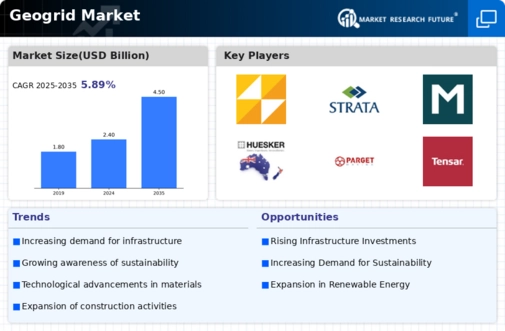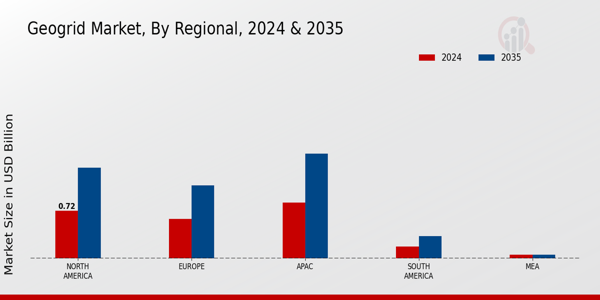Increased Urbanization
Rapid urbanization across the globe is driving the demand for geogrids in the Global Geogrid Market Industry. As cities expand, the need for effective land management and infrastructure development becomes critical. Geogrids play a vital role in stabilizing soil in urban environments, where space is limited and construction challenges are prevalent. The integration of geogrids in urban projects helps mitigate issues related to soil erosion and ground settlement, ensuring the longevity of structures. This trend is likely to continue, as urban areas are projected to grow, further propelling the demand for geogrids in various applications.
Market Growth Projections
The Global Geogrid Market Industry is projected to experience substantial growth over the coming years. With a market value of 2.4 USD Billion in 2024, it is expected to reach 4.5 USD Billion by 2035. This growth trajectory indicates a robust demand for geogrids, driven by factors such as infrastructure development, urbanization, and sustainability initiatives. The anticipated compound annual growth rate (CAGR) of 5.88% from 2025 to 2035 further underscores the potential for expansion within the industry. These projections highlight the increasing recognition of geogrids as vital components in enhancing the performance and longevity of construction projects.
Infrastructure Development
The ongoing expansion of infrastructure projects globally serves as a primary driver for the Global Geogrid Market Industry. Governments and private entities are increasingly investing in roadways, railways, and airports, necessitating the use of geogrids to enhance soil stability and reduce maintenance costs. For instance, in 2024, the market is projected to reach 2.4 USD Billion, reflecting the growing demand for durable construction materials. The integration of geogrids in these projects not only improves structural integrity but also contributes to sustainable practices by minimizing environmental impact. As infrastructure development accelerates, the Global Geogrid Market Industry is poised for significant growth.
Government Regulations and Standards
Government regulations and standards promoting the use of geogrids in construction are shaping the Global Geogrid Market Industry. Many countries are implementing stricter guidelines to enhance infrastructure safety and sustainability. These regulations often mandate the use of geogrids in specific applications, such as road construction and earthworks, to ensure stability and durability. Compliance with these standards not only improves project outcomes but also encourages the adoption of geogrids among contractors and engineers. As regulatory frameworks evolve, the market is likely to benefit from increased awareness and acceptance of geogrids as essential components in modern construction practices.
Rising Demand for Sustainable Construction
The Global Geogrid Market Industry is witnessing a surge in demand for sustainable construction practices. As environmental concerns gain prominence, builders and engineers are increasingly opting for geogrids, which offer enhanced performance while reducing the carbon footprint of construction projects. Geogrids facilitate efficient load distribution and soil reinforcement, leading to longer-lasting structures. This trend aligns with global sustainability goals, prompting regulatory bodies to encourage the use of eco-friendly materials. The anticipated growth of the market to 4.5 USD Billion by 2035 underscores the potential of geogrids in promoting sustainable development within the construction sector.
Technological Advancements in Geogrid Manufacturing
Technological innovations in the manufacturing of geogrids are significantly influencing the Global Geogrid Market Industry. Advanced production techniques, such as the use of high-strength polymers and innovative weaving methods, enhance the performance characteristics of geogrids. These advancements lead to products that are lighter, stronger, and more durable, thereby increasing their applicability in various construction projects. As a result, the market is expected to experience a compound annual growth rate (CAGR) of 5.88% from 2025 to 2035. The continuous evolution of manufacturing processes not only improves product quality but also expands the range of applications for geogrids in infrastructure development.










